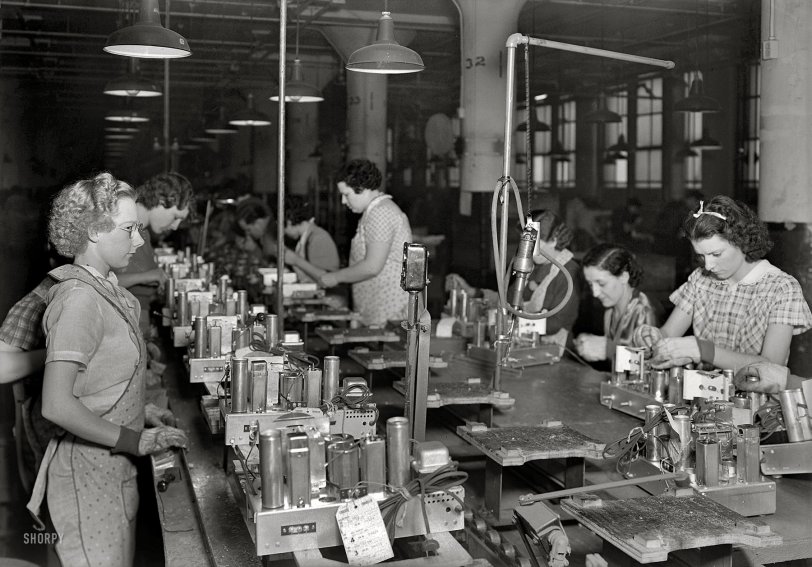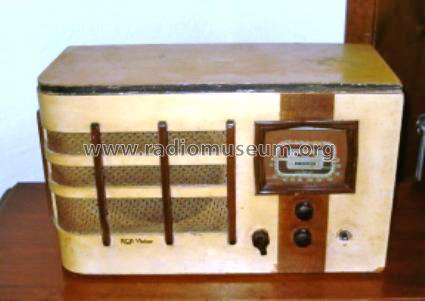


Framed or unframed, desk size to sofa size, printed by us in Arizona and Alabama since 2007. Explore now.
Shorpy is funded by you. Patreon contributors get an ad-free experience.
Learn more.

- Lost in Toyland
- And without gloves
- If I were a blindfolded time traveler
- Smoke Consumer Also Cooks
- Oh that stove!
- Possibly still there?
- What?!?
- $100 Reward
- Freeze Frame
- Texas Flyer wanted
- Just a Year Too Soon
- WWII -- Replacing men with women at the railroad crossing.
- Yes, Icing
- You kids drive me nuts!
- NOT An Easy Job
- I wonder
- Just add window boxes
- Icing Platform?
- Indiana Harbor Belt abides
- Freezing haze
- Corrections (for those who care)
- C&NW at Nelson
- Fallen Flags
- A dangerous job made worse
- Water Stop
- Passenger trains have right of way over freights?
- Coal
- Never ceases to amaze me.
- Still chuggin' (in model form)
- Great shot
Print Emporium
Five-Tube Chassis: 1937

March 1937. "Camden, New Jersey. RCA Victor. Five-tube chassis assembly line." Radio like Grandma used to make. Photo by Lewis Hine. View full size.
Five-tube Crosley
The lady wearing glasses in the foreground seems to operating with a decent chassis but more importantly when I was a lad Pop owned a 5-tube Crosley superheterodyne receiver. We were on Long Island but at night that beast could pull in the race results from Bowie in Maryland and River Downs out in Ohio.
Atwater-Kents
And, nixiebunny, the Atwater-Kents were tuned radio frequency (TRF) receivers that were cranky to tune and pretty unstable. These radios used superheterodyne technology invented by Edwin H. Armstrong that made using a radio easy, stable, and reliable. Armstrong also corrected faulty vacuum-tube theory, invented the regenerative receiver, the Super-regenerative circuit, and FM radio.
Ah, the All-American Five!
The five-tube chassis was a classic, and many versions graced American homes. These seem to have a power transformer that made the chassis safer than the cheaper models that ran directly off 110 volt AC power lines. A touch to a transformerless chassis and a good ground could deliever quite a shock!
Still using a power transformer
The venerable five tube concept would not long after this abandon the big power transformer on the right for a direct, non-isolated connection to the AC mains. Saved a lot of money, but could be a surprise for an unwary tinkerer. "Miniaturization" during WWII would shrink the light-bulbish tubes and large coils to something about 1/3 the size of what we see here. That lead way to legions of bread-loaf sized radios in the 50's on, some of which are now considered art pieces. Should have held on to those things!
Female workers
Women in the workplace was not a WWII invention. Women entered manufacturing at the dawn of the industrial revolution. In Lowell, MA the mill owners recruited young women and built living quarters for them. When food processing evolved, it was common to see plants full of women performing the cleaning and canning operations. By the turn of the last century, most apparel sweatshops employed girls and women - remember the Triangle Shirtwaist Fire of 1911?
Not all women
That is either a man in the background leaning over with his thumb to his nose, or the lady needs an apology from me. Women were better suited (no pun intended) for these types of jobs since their hands fit the gloves better. And when you aren't working, you can pose like a model and no one will suspect your true ambitions.
Curious
Why were all the workers women? This looks more like a shot you'd see from 5-ish years later in the midst of the war.
1936 designed hardware ?
Looks like a 5T7 model: http://www.radiomuseum.org/r/rca_5t7.html

Designed for mass production
Compare these to the Atwater Kents of the twenties. The A-K radios were more like an Erector set, all the little fiddly bits held together by screws and nuts. Every assembler had a tray of hardware from which to build the tuning assembly.
The tuning capacitor and IF coils in these radios are made of stamped steel pieces, designed to fit together like puzzles and held together by bent-over tabs in slots. This style of construction was used through the sixties, when the Japanese replaced it with little molded plastic pieces.
























On Shorpy:
Today’s Top 5